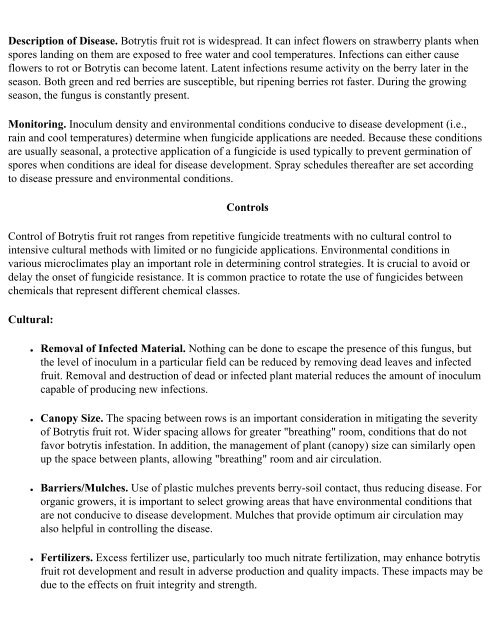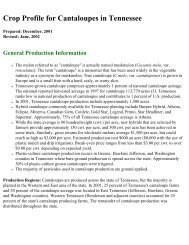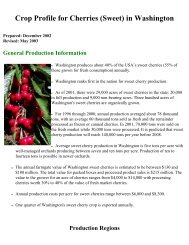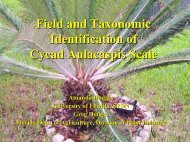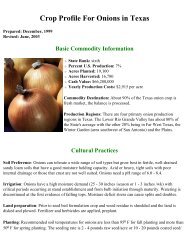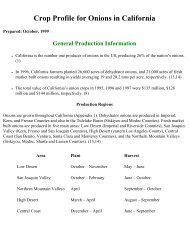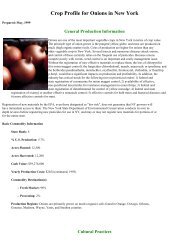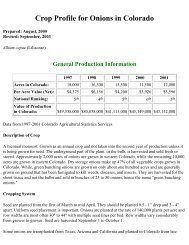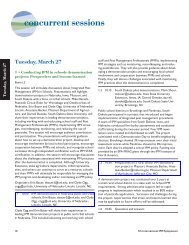Crop Profile for Strawberries in California - Regional IPM Centers
Crop Profile for Strawberries in California - Regional IPM Centers
Crop Profile for Strawberries in California - Regional IPM Centers
You also want an ePaper? Increase the reach of your titles
YUMPU automatically turns print PDFs into web optimized ePapers that Google loves.
Description of Disease. Botrytis fruit rot is widespread. It can <strong>in</strong>fect flowers on strawberry plants when<br />
spores land<strong>in</strong>g on them are exposed to free water and cool temperatures. Infections can either cause<br />
flowers to rot or Botrytis can become latent. Latent <strong>in</strong>fections resume activity on the berry later <strong>in</strong> the<br />
season. Both green and red berries are susceptible, but ripen<strong>in</strong>g berries rot faster. Dur<strong>in</strong>g the grow<strong>in</strong>g<br />
season, the fungus is constantly present.<br />
Monitor<strong>in</strong>g. Inoculum density and environmental conditions conducive to disease development (i.e.,<br />
ra<strong>in</strong> and cool temperatures) determ<strong>in</strong>e when fungicide applications are needed. Because these conditions<br />
are usually seasonal, a protective application of a fungicide is used typically to prevent germ<strong>in</strong>ation of<br />
spores when conditions are ideal <strong>for</strong> disease development. Spray schedules thereafter are set accord<strong>in</strong>g<br />
to disease pressure and environmental conditions.<br />
Controls<br />
Control of Botrytis fruit rot ranges from repetitive fungicide treatments with no cultural control to<br />
<strong>in</strong>tensive cultural methods with limited or no fungicide applications. Environmental conditions <strong>in</strong><br />
various microclimates play an important role <strong>in</strong> determ<strong>in</strong><strong>in</strong>g control strategies. It is crucial to avoid or<br />
delay the onset of fungicide resistance. It is common practice to rotate the use of fungicides between<br />
chemicals that represent different chemical classes.<br />
Cultural:<br />
● Removal of Infected Material. Noth<strong>in</strong>g can be done to escape the presence of this fungus, but<br />
the level of <strong>in</strong>oculum <strong>in</strong> a particular field can be reduced by remov<strong>in</strong>g dead leaves and <strong>in</strong>fected<br />
fruit. Removal and destruction of dead or <strong>in</strong>fected plant material reduces the amount of <strong>in</strong>oculum<br />
capable of produc<strong>in</strong>g new <strong>in</strong>fections.<br />
● Canopy Size. The spac<strong>in</strong>g between rows is an important consideration <strong>in</strong> mitigat<strong>in</strong>g the severity<br />
of Botrytis fruit rot. Wider spac<strong>in</strong>g allows <strong>for</strong> greater "breath<strong>in</strong>g" room, conditions that do not<br />
favor botrytis <strong>in</strong>festation. In addition, the management of plant (canopy) size can similarly open<br />
up the space between plants, allow<strong>in</strong>g "breath<strong>in</strong>g" room and air circulation.<br />
● Barriers/Mulches. Use of plastic mulches prevents berry-soil contact, thus reduc<strong>in</strong>g disease. For<br />
organic growers, it is important to select grow<strong>in</strong>g areas that have environmental conditions that<br />
are not conducive to disease development. Mulches that provide optimum air circulation may<br />
also helpful <strong>in</strong> controll<strong>in</strong>g the disease.<br />
● Fertilizers. Excess fertilizer use, particularly too much nitrate fertilization, may enhance botrytis<br />
fruit rot development and result <strong>in</strong> adverse production and quality impacts. These impacts may be<br />
due to the effects on fruit <strong>in</strong>tegrity and strength.


